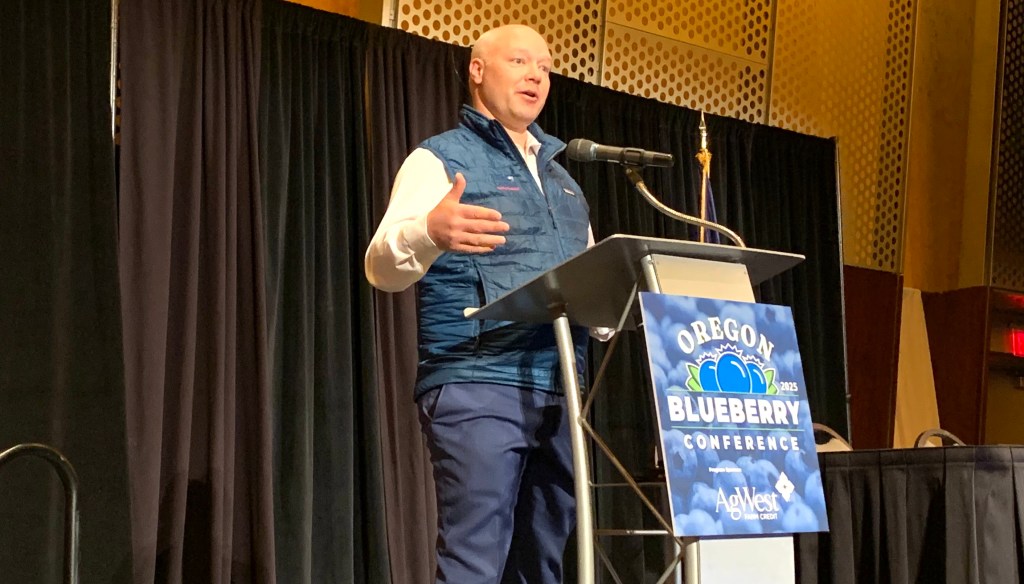ONLINE Dan Fulleton Farm Equipment Retirement Auction
THIS WILL BE AN ONLINE AUCTION Visit bakerauction.com for full sale list and information Auction Soft Close: Mon., March 3rd, 2025 @ 12:00pm MT Location: 3550 Fulleton Rd. Vale, OR […]
Published 11:04 am Wednesday, February 5, 2025

SALEM, Ore. — The Oregon Blueberry Conference brought growers, researchers and industry members together for discussions of production, trade, pesticides and pollination on Feb. 4.
The event was held against the backdrop of tariff threats from President Donald Trump and a proposed assessment increase to boost blueberry demand.
A meeting on the increase is scheduled for 9 a.m. Feb 21 at the Holiday Inn in Salem.
Kasey Cronquist, president of the U.S. Highbush Blueberry Council, said the tentative proposal separated processed and fresh berries for the first time.
Processed would be assessed at 1.5 cents per pound and fresh at 2.5 cents per pound. The current rate is 0.9 cents per pound.
Oregon State University professor Vaughn Walton gave a presentation on fighting spotted wing drosophila with targeted drone applications.
A bait spray method to attract and kill the flies rather than full coverage application can get similar results with a tenth of the active ingredient and volume.
That lowers costs and is better for the environment, Walton said.
The method also can be used with some chemicals for the organic industry, he added.
Paul Pryce, executive director of the BC Blueberry Council in British Columbia, Canada, quipped he should have used a less stuffy presentation title, such as “Don’t Tariff Me, Bro.”
Blueberry trade between Canada and the U.S. is symbiotic, with each the top export market for the other.
Canada will replant about a third of its acreage through a government program, leading to a production lull before gains.
That could present an opportunity.
“Canadians cannot get enough blueberries. They are crazy about blueberries,” Pryce said.
British Columbia’s blueberry crop was 180 million pounds in 2024, almost double the previous year, but there were quality challenges, with many split berries being frozen, Pryce said.
Alyssa Houtby, North American Blueberry Council director of government affairs, talked about delayed tariffs on Canada and Mexico.
“There’s still a lot to be negotiated. Those tariffs are very much on the table,”
Discussions are underway with the USDA about mitigation programs if tariffs are levied.
Houtby said the blueberry industry has cultivated a relationship with Lori Chavez-DeRemer, Trump’s pick for labor secretary. The former Oregon representative is committed to solving farmers’ crisis with H-2A migrant workers, Houtby said.
She added that the industry continues to look to make domestic growers more competitive and level the playing field with foreign berries that can have lower costs for production.
Haiying Zhang, NABC director of Global Business Development, said there were tremendous opportunities for exports.
U.S. blueberry export volume through November in 2024 increased 14% over the previous year to nearly 166 million pounds. That was 23% of the total harvest, up 3 percentage points from 2023.
About two-thirds of U.S. exports are fresh, she said.
In 2025, the USHBC will elevate efforts to boost demand and create a coordinated global marketing campaign for consistent messaging.
Micah Weiss, area manager for Fall Creek Farm & Nursery, said Peru has surpassed the U.S. in fresh blueberry production.
Our summer is now becoming a gap for supply and quality — consumers are prioritizing larger, firmer berries coming from South America and paying more for that fruit, Weiss said.
Fall Creek is working on machine harvest trials, and firmness is one of the major factors for successful berries.
“We can make that same quality fruit with better flavor here,” Weiss said, but he added it will take time to build volume.